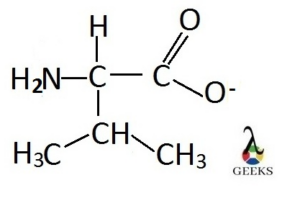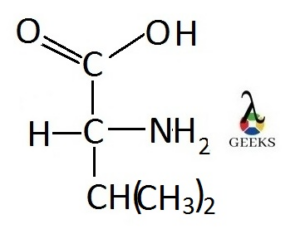In a human body, twenty types of Amino acids are found. This article describes the Valine amino acid structure and its properties.
Some α-amino acids which human body can’t bio-synthesize, are known as essential amino acids. valine is an essential amino acid. The chemical name of Valine is 2-amino-3-methylbutanoic acid. Valine amino acid structure is non-polar in nature.
Structure of Amino acid: Valine
Amino acids are carboxylic acids with amino group. Molecular formula of valine is C5H11NO2. It is denoted as “Val”.
Amino acids have commonly two main functional groups. Among these one group is amino group (-NH2) and another functional group is Carboxyl group (-COOH). Beside these the amino acid structures have a side chain attached to the mid-point Carbon atom. The chain is shown as ‘R’ for general structure.
(-NH2) group and the (-COOH) group are common in valine amino acid structure like other amino acids. A hydrocarbon group (isopropyl group) is the “R” group in the Valine structure. There also an α-Hydrogen atom is attached to the Carbon atom of Valine.
Valine as an alpha (α) amino acid
The alpha (α) amino acids are basic component of protein molecules.
The center Carbon atom of Amino acid is connected with both the amino group and the carboxyl group, the Amino acid is named as alpha (α) – Amino acid.
In Valine structure both (-NH2) and (-COOH) groups are attached to the one Carbon atom in the middle of the molecule. Hence it can be referred to the α-amino acid.

Zwitterion of Valine amino acid structure
If a molecule carries both opposite charged groups that is positive and negative in equal number, this molecule is identified as a zwitter ion.
Amino acids has both (-NH2) and (-COOH) groups. (-COOH) group is acidic in nature so it can transfer the Hydrogen atom. This H+ ion is accepted by the Nitrogen atom of amino group as it is basic in nature. Hence Valine exists as a zwitter ion with both opposite charged groups.
As a dipolar ion, positive and negative charges are present in the Valine molecule. Both the contrasting charges cancel out each other. As a whole the Valine molecule remains as neutral molecule.

The amino acids have charge separation present in the zwitter ion form. So Valine can conduct electricity for the configuration with charges in the solid phase.
pH dependence of Valine structure
The stability of the dipolar ion of the amino acid depends on the pH of the solution.
At a lower pH (acidic pH), the ion accepts H+ ion from solution and forms positive charged ion. In a higher pH (strong basic pH), the ion transfers hydrogen ion (H+) and forms a molecule with negative charge.

At a particular pH value an amino acid remains as a zwitterion which is called the isoelectric point of that amino acid in that solution. For Valine the isoelectric point is 6.0.

Hydrophobic nature of Valine
If a molecule or a part of it resists contact with the water molecule, then the nature is called hydrophobic nature.
Valine has isopropyl group in the branched hydrocarbon side chain of the center atom. It is a non-polar group. This makes it hydrophobic in nature.
Solubility of Valine amino acid
Solubility of Valine depends on the side isopropyl chain, pH of solution etc.
As Valine structure carries charged groups like carboxylaate and aminium, it can soluble in water at a certain temperature.
But Valine can’t soluble in non-polar solvents, like Benzene. Because these solvents which are not polar can’t able to dissolve the ionic part of Valine molecule.
Chiral Carbon of Valine molecule
Carbon atom can make four bonds in a molecule. If the four groups or atoms are distinct; then the Carbon atom is named as a chiral Carbon center.
A molecule with chiral carbon has optical rotatory power. In order to arrangement of the groups in the molecule, it classifies as ‘D’ and ‘L’ isomer. These structures are carbon copy with respect to each other with same molecular formula but not super impose.
Valine has four distinct groups around the Carbon in the center. So Valine is optically active molecule. It has two individual structures like D- Valine and L- Valine.

The planer structure of Valine with D-configuration has the amino group (-NH2) to the right side of the Carbon atom. The Valine with L-configuration has the amino group to the left side of the Carbon atom. The Hydrogen atom (α) is in the horizontal position in both structures.

Peptide bond formation
Amino acids are the basic component in protein structure.
Amino acids are joining one after another like blocks to produce protein molecules. The new amide bond which formed is called the Peptide bond.
The amide bond is occurs between the carboxyl group and amino group of two adjacent Amino acid. The left side of long chain is called N- terminus which have a free amino group and right side of the chain is called C- terminus with a free carboxyl group.
Valine also participates in peptide bond formation to produce proteins.

Hi…I am Triyasha Mondal, pursuing M.Sc in Chemistry. I am an enthusiastic learner. My specialization is in physical chemistry.
Let’s connect through LinkedIn: